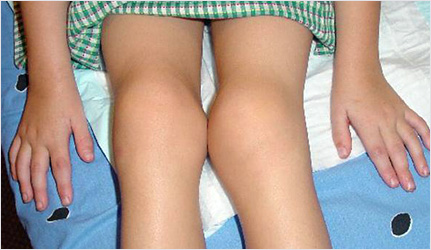
Several types of arthritis, all involving chronic (long-term) joint inflammation, fall under the JIA heading. This inflammation begins before patients reach the age of 16, and symptoms last from 6 weeks to 3 months to be called chronic. JIA may involve one or many joints, and cause other symptoms such as fevers, rash and/or eye inflammation.
1) Systemic onset JIA affects about 10 percent of children with arthritis. It begins with repeating fevers that can be 103°F or higher, often accompanied by a salmon-colored rash that comes and goes. Systemic onset JIA may cause inflammation of the internal organs as well as the joints, though joint swelling may not appear until months or even years after the fevers begin. Anemia (a low red blood cell count) and elevated white blood cell counts are also typical findings in blood tests ordered to evaluate the fevers and ongoing symptoms. Arthritis may persist even after the fevers and other symptoms have disappeared.
2) Oligoarticular JIA, which involves fewer than five joints in its first stages, affects about half of all children with arthritis. Girls are more at risk than boys. Older children with oligoarticular JIA may develop "extended" arthritis that involves multiple joints and lasts into adulthood. Children who develop the oligoarticular form of JIA when they are younger than 7 years old have the best chance of having their joint disease subside with time. They are, however, at increased risk of developing an inflammatory eye problem (iritis or uveitis). Eye inflammation may persist independently of the arthritis. Because iritis usually does not cause symptoms, regular exams by an ophthalmologist (eye doctor) are essential to detect these conditions and identify treatment to prevent vision loss.
3) Polyarticular JIA affects five or more joints and can begin at any age. Children diagnosed with polyarticular JIA in their teens may actually have the adult form of rheumatoid arthritis at an earlier-than-usual age.
With psoriatic arthritis, children have both arthritis and a skin disease called psoriasis or a family history of psoriasis in a parent or sibling. Typical signs of psoriatic arthritis include nail changes and widespread swelling of a toe or finger called dactylitis.
4) Enthesitis-Related Arthritis is a form of JIA that often involves attachments of ligaments as well as the spine. This form is sometimes called a spondyloarthropathy. These children may have joint pain without obvious swelling and may complain of back pain and stiffness.

Malfunctioning of the immune system in JIA targets the lining of the joint, known as the synovial membrane. This causes inflammation. When the inflammation persists, joint damage may occur. (See diagram of normal joint versus inflamed joint below.)
Juvenile Idiopathic ArthritisIt is not known what causes the immune system to malfunction in JIA. These conditions are not considered hereditary and rarely involve more than one family member. Research suggests that some individuals may have a genetic tendency to develop JIA, but develop the condition only after exposure to an infection or other unknown trigger. Dietary and emotional factors do not appear to play a role in the development of JIA.
Because the causes of JIA are unknown, no one knows how to prevent these conditions.

JIA may be difficult to diagnose because some children may not complain of pain at first, and joint swelling may not be obvious. There is no blood test that can be used to diagnose the condition and adults with rheumatoid arthritis typically have a positive rheumatoid factor blood test, but children with JIA typically have a negative rheumatoid factor blood test. As a result, diagnosis of JIA depends on physical findings, medical history and the exclusion of other diagnoses.
Typical symptoms include:
1) Limping
2) Stiffness when awakening
3) Reluctance to use an arm or leg
4) Reduced activity level
5) Persistent fever
6) Joint swelling
7) Difficulty with fine motor activities
Other conditions that can look like JIA, including infections, childhood cancer, bone disorders, Lyme disease and lupus also must be ruled out before a diagnosis of JIA can be confirmed.